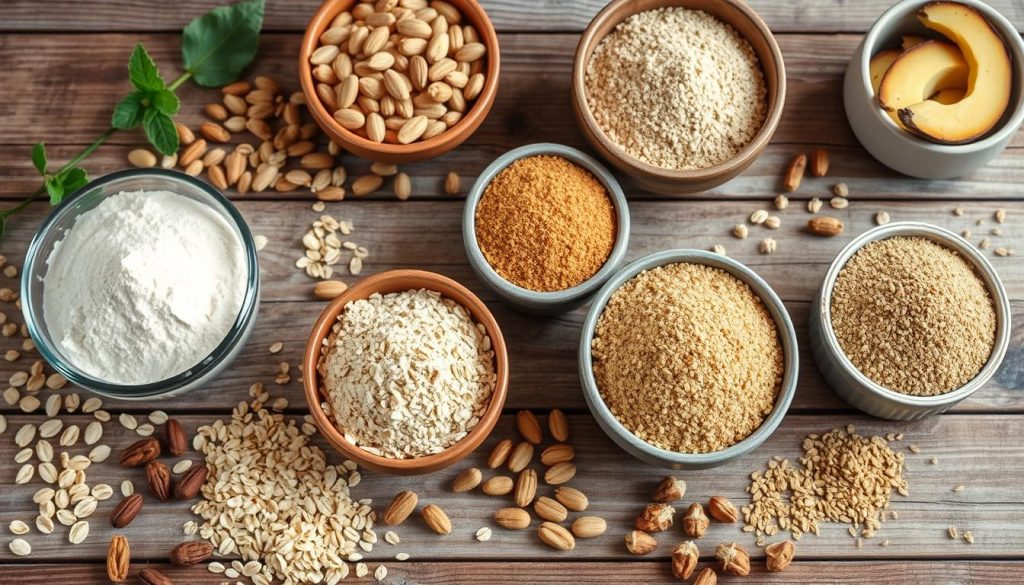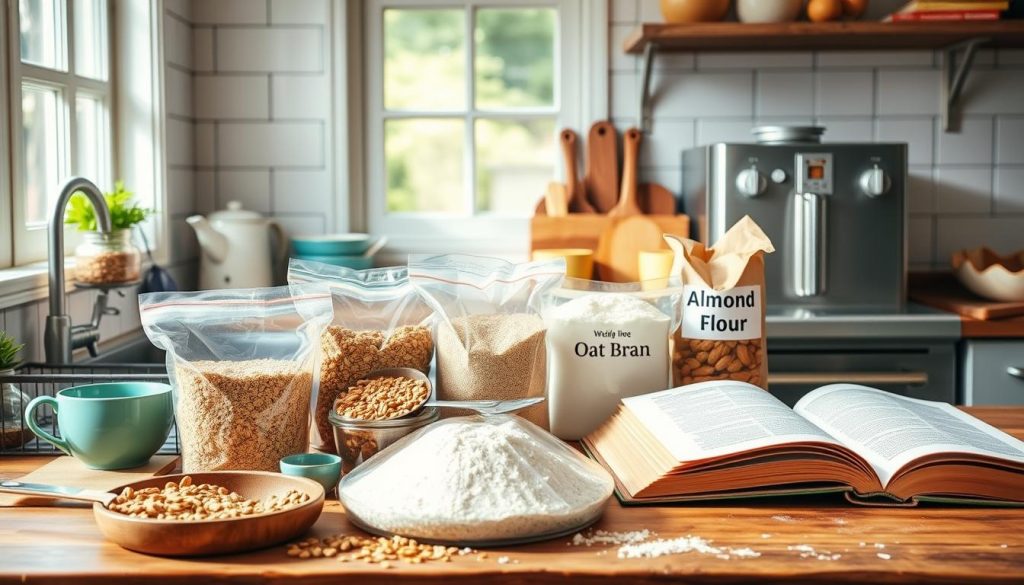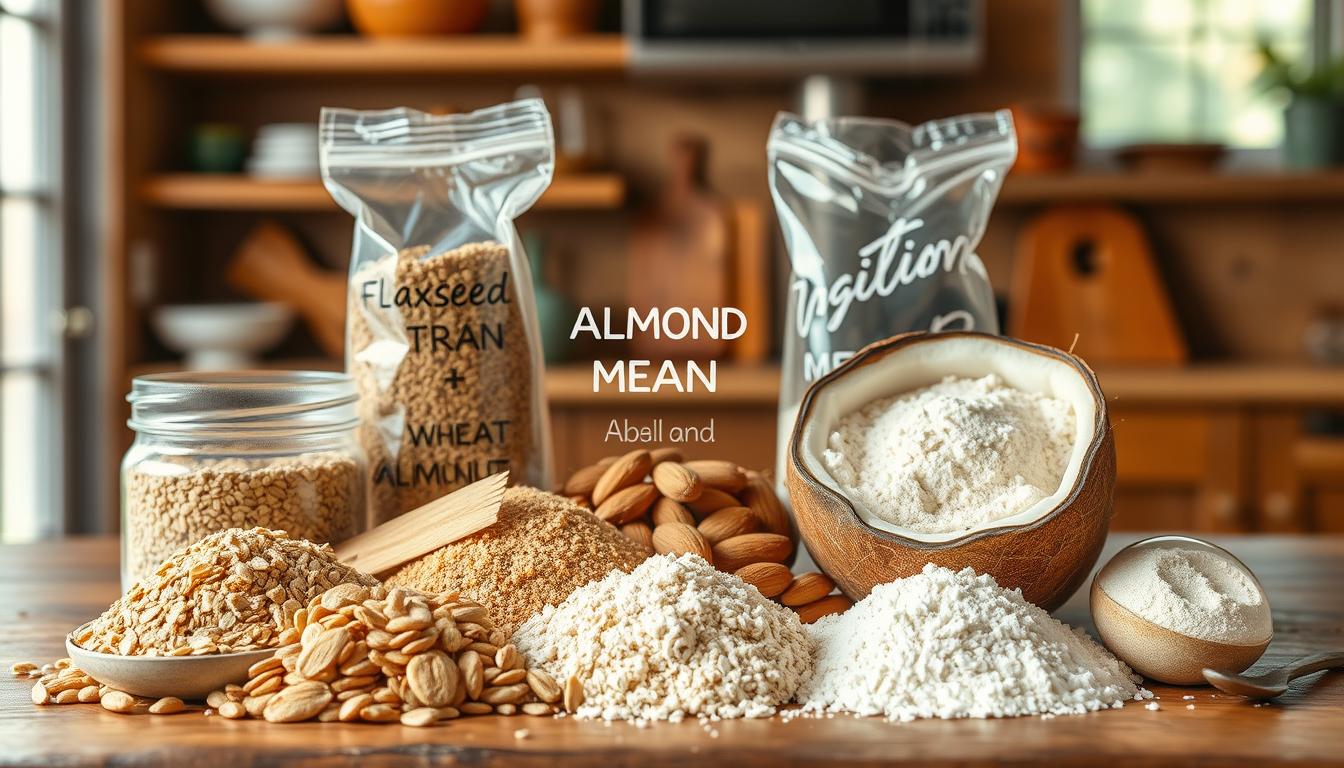If you’re searching for oat bran substitutes, you’re in the right spot. Oat bran is known for its health benefits and high fiber. It’s a favorite in many recipes. But sometimes, you might need to find other options.
This could be because of availability, dietary needs, or personal taste. Knowing good substitutes helps keep your dishes tasty and textured. In this guide, you’ll find many options to make your cooking easier.
Introduction to Oat Bran and Its Uses
Oat bran is becoming more popular for its health benefits and many uses in cooking. Knowing what oat bran is helps you see its value in a healthy diet and in recipes. This ingredient adds flavor and health benefits to your meals.
What is Oat Bran?
Oat bran is the outer layer of the oat groat, known for its high fiber and health benefits. It’s full of soluble fiber, making it great for diets. It’s used in baked goods and cereals, adding sweetness and texture to your food.
Nutritional Benefits of Oat Bran
Exploring oat bran nutrition shows its amazing benefits. A cup of cooked oat bran has 6 grams of fiber and 7 grams of protein. It supports digestion and overall health. It also has important nutrients like:
- 29% of the Reference Daily Intake (RDI) of thiamine
- 21% of the RDI of magnesium
- 21% of the RDI of phosphorus
- 11% of the RDI of iron
- 11% of the RDI of zinc
These nutrients help your heart and help with weight management because of fiber’s ability to keep you full.
Common Uses in Recipes
Adding oat bran to your meals can make them healthier without losing flavor. You can find oat bran in many recipes with oat bran, like:
- Breads and muffins for extra fiber
- Smoothies to increase nutrition
- Thickening agents for soups and stews
Using oat bran in recipes not only tastes good but also boosts fiber. It’s a smart choice for those who care about their health. Its versatility makes it a great addition to any kitchen, offering both nutrition and enjoyment.
Understanding the Need for Oat Bran Substitutes
Finding alternatives in cooking is key. You might ask why substitute oat bran. This could be due to running out of oat bran or dietary restrictions like gluten intolerance or oat allergies. Knowing why you need a substitute helps you plan better in the kitchen.
Reasons You Might Need a Substitute
Several factors might make you look for substitutes. Here are a few:
- Availability: You might unexpectedly run out of oat bran.
- Dietary Restrictions: People with gluten intolerance or oat allergies need alternatives.
- Nutrition Goals: You might want different nutritional profiles, like lower calories or specific vitamins.
How Substituting Affects Your Recipes
Substituting ingredients can change your dish’s flavor and texture. It’s important to know each substitute’s unique traits:
- Oat bran has a high protein content at 16.3g per 1-cup serving, while wheat bran has 9g.
- Oat bran is rich in soluble fiber, good for blood sugar, but wheat bran is mostly insoluble fiber, better for digestion.
- Oat bran has 231 calories per cup, while wheat bran has 125, affecting calorie-conscious choices.
Adjusting ratios or cooking times might be needed based on the substitute. Knowing how substitutes affect your dishes ensures they taste good and are consistent. This makes cooking fun and enjoyable.
Top Oat Bran Substitute Guide
Looking for a good oat bran substitute can make your recipes better and keep them healthy. Here are the best options, each with its own taste and texture. They’re great for different types of cooking.
Wheat Bran
Wheat bran is full of fiber and tastes slightly nutty. It’s coarse and can replace oat bran 1:1. It’s perfect for cereals, breads, and muffins.
Rolled Oats
Rolled oats are sweet and chewy. They’re a great 1:1 substitute for oat bran. They’re great in baked goods like breads, muffins, and cookies.
Ground Flaxseed
Ground flaxseed has an earthy taste and a gritty feel. It’s a 1:1 substitute for oat bran. It’s good in pancakes, breads, and smoothies, adding fiber.
Chia Seeds
Chia seeds taste neutral and turn gelatinous when mixed with liquid. They’re a 1:1 substitute for oat bran. They’re perfect for puddings, smoothies, and baked goods.
Almond Flour
Almond flour tastes nutty and is fine in texture. It’s great for cakes, cookies, and breads. Use it 1:1 for oat bran, but adjust liquids because it absorbs a lot.
Coconut Flour
Coconut flour tastes mildly sweet. Use it 1:4 as an oat bran substitute. It absorbs a lot of liquid, so add more to your recipes. It’s perfect for cakes, muffins, and pancakes.
Psyllium Husk
Psyllium husk is known for binding well. It’s a 1:1 substitute for oat bran. It’s especially good for gluten-free baking because it holds moisture.

| Substitute | Ratio | Flavor | Texture Suitability |
|---|---|---|---|
| Wheat Bran | 1:1 | Nutty | Coarse |
| Rolled Oats | 1:1 | Mildly Sweet | Chewy |
| Ground Flaxseed | 1:1 | Earthy | Gritty |
| Chia Seeds | 1:1 | Neutral | Gelatinous |
| Almond Flour | 1:1 | Nutty | Fine |
| Coconut Flour | 1:4 | Mildly Sweet | Light |
| Psyllium Husk | 1:1 | Neutral | Gel-like |
Choosing the Right Substitute for Your Recipe
Choosing the right substitute for oat bran is key. You need to know how each option changes your dish. This includes flavor, texture, and nutrition. Knowing these details helps make your cooking better.
Flavor Comparisons
Each substitute has its own taste. This can change your dish a lot. When choosing oat bran substitutes, think about how flavors mix:
- Almond flour: Adds a nutty taste, making flavors richer.
- Wheat bran: Brings a mild earthy flavor, grounding your recipe.
- Ground flaxseed: Offers a subtle nutty taste with a hint of sweetness.
- Coconut flour: Gives a tropical flavor with sweet notes.
Texture Considerations
The texture in cooking matters a lot. Different substitutes change the dish’s density or crunchiness. For example:
- Psyllium husk: Creates a gel-like texture, great for binding.
- Ground flaxseed: Adds a nice crunch, improving the dish’s texture.
- Coconut flour: Absorbs moisture, making the dish denser.
- Wheat bran: Adds fiber without changing the dish’s texture too much.
Nutritional Impact of Each Substitute
Knowing the nutrition of each substitute is important. It helps with dietary choices when choosing oat bran substitutes. Here’s a comparison:
| Substitute | Calories (per cup) | Fiber (grams) | Nutritional Benefits |
|---|---|---|---|
| Oat Bran | 230 | 15 | Contains soluble fiber, carbs, fats, and proteins. |
| Wheat Bran | 125 | 25 | Rich in insoluble fiber, cost-effective. |
| Ground Flaxseed | 150 | 30 | High in omega-3 fatty acids, adds crunch. |
| Almond Flour | 600 | 12 | Nutrient-rich, adds moisture and flavor. |
| Coconut Flour | 480 | 38 | High fiber, dense texture. |

Conclusion
In this guide, we’ve looked at many oat bran substitutes. Each has its own uses in cooking and baking. You can use wheat bran, rolled oats, or almond flour to replace oat bran in recipes. This summary shows how to keep your meals nutritious while trying new things.
It’s key to know the differences between these substitutes. For example, oat bran is great for lowering cholesterol. But ground flaxseed and chia seeds offer other health benefits. By trying different options, you can make dishes that taste good and meet your dietary needs.
Feel free to try out these substitutes in your cooking. A bit of creativity and the right tips can lead to exciting new flavors and textures. The best substitute for oat bran can change with each dish. So, don’t be afraid to experiment and find what works best for you.
Source Links
- https://crumbuns.ca/contentai/substitute-for-oat-bran
- https://gustomeadow.com/oat-bran-substitutes/
- https://discover.texasrealfood.com/swap-and-savor/how-to-substitute-oat-bran-for-wheat-bran
- https://www.healthline.com/nutrition/oat-bran
- https://www.goodness.com.au/blog/oats-101-a-comprehensive-guide-to-understanding-and-enjoying-oats/?srsltid=AfmBOorRhbWPPuxAog5kbV4Ey5OBceoH7Z4EIqHWb8l7aklwfVGZf3zO
- https://www.helpforibs.com/messageboards/ubbthreads/showflat.php?Cat=&Board=recipe&Number=170981&page=1&view=expanded&sb=9&o=all&fpart=all&vc=1
- https://discover.texasrealfood.com/swap-and-savor/how-to-substitute-wheat-bran-for-oat-bran
- https://wholegrainscouncil.org/blog/2020/02/notes-oats
- https://cookscrafter.com/oat-bran-substitutes/
- https://thecoconutmama.com/oat-bran-vs-oat-flour/
- https://gwens-nest.com/oat-fiber-vs-oat-bran/
- https://mygreenmisadventure.wordpress.com/2015/12/03/oat-bran-versus-wheat-bran/
- https://www.improvingmedicalstatistics.com/oatbran meta-analysis.htm
- https://discover.texasrealfood.com/swap-and-savor/how-to-substitute-wheat-bran-for-oat-bran-in-baking
- https://pmc.ncbi.nlm.nih.gov/articles/PMC7382162/
